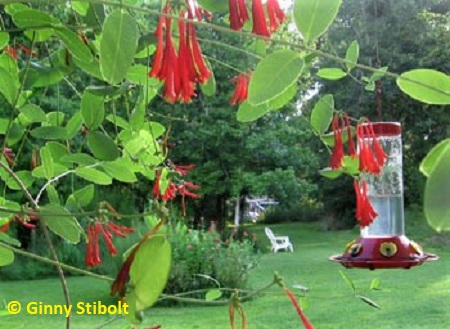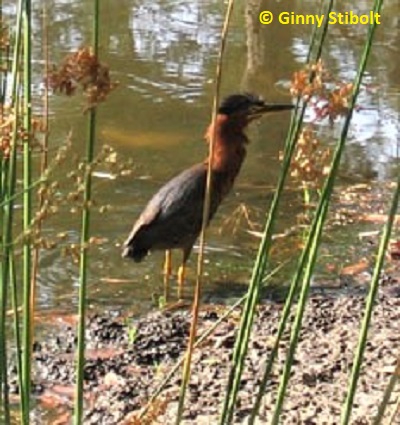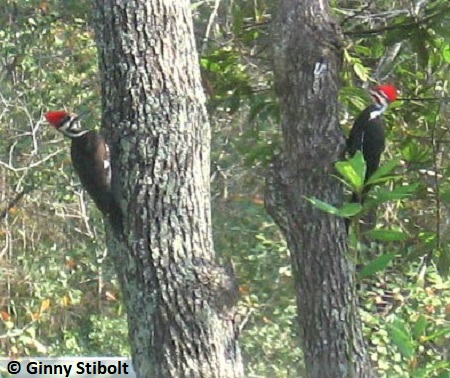Adventures of a Transplanted Gardener |
|||
Invite birds to your yard
| |||
 A bird-friendly yard with native plants and meadows. |
The Florida Audubon Society estimates that populations of our birds have declined by more than 80% in the last 50 years. Most of this is due to the shrinkage of habitat, but as a homeowner you can help tip the scale in the other direction. Create habitat by reducing your lawn area and by planting trees and shrubs that provide cover and food for birds.
The guidelines supplied by organizations, such as National Wildlife Federation and Florida's Extension Service (See below.), to certify yards as habitat are useful because having a list of projects to accomplish helps define the process. Of course, you can follow the guidelines to provide habitat without the certification and once you get started, you'll probably wish to expand your habitat because once you invite beautiful birds to your property, you'll want more, because they're beautiful and entertaining to watch.
To invite birds to your yard,
... you must first invite the bugs
Before you start any habitat project, stop using all pesticides. Allow your bugs and their predators (bird, frogs, bats, and lizards) reach a balance. The predators' populations will vary depending upon the abundance of their prey. Letting Mother Nature to do the heavy lifting saves you money and time, plus the pollution from your property will be minimized. This is also part of your butterfly gardening strategy.
Birds need food--lots of it
Good habitat should have a wide variety of flower types, berries, seeds, and nuts. Hummingbirds are attracted to reddish tubular flowers for their nectar, but will visit many types of flowers. Berries and seeds are important food for many songbirds, particularly when they are migrating. Some insect-eating birds shift to berries when the bug population is low. Work to create a selection of native berry-bearing shrubs and trees. In Florida, some plants might hold their berries through the cooler months and would be available in the spring, but the majority will provide food from late summer through late fall. To provide seeds large and small, don't deadhead all of your flowers--leave some of them in place and let them go to seed. Leave your meadow areas uncut until late winter and leave the cuttings in place as a mulch to provide the best supply of seeds.
Food for wildlife is best supplied by plants and animals in a balanced ecosystem, but you may supplement the naturally occurring food with feeders. Hummingbirds pollinate our flowers and eat insects, but in between flowering, you can support their population by providing sugar water for them. (Mix one part sugar with four parts of water and don't dye it red--use a feeder with red parts instead.) Food for seed feeders is quite popular, but make sure that you keep the area relatively clean. Once you start feeding, these food sources should be reliably maintained during same time each year.
 |
A little green heron stalks along the edge of our front pond. >>
Birds love water features
Birdbaths are probably the simplest way to provide water, but you may find that here in Florida, the water gets so hot in the sun that birds won't use it. You could install a birdbath in a shady spot. More birds will use a water source if there are nearby trees and shrubs with branches suitable for perching. Empty the water every three days to prevent mosquitoes from hatching. A birdbath with a solar-powered circulating pump running a gently flowing fountain will keep the water cooler and be easier to maintain. Moving water may also be more attractive to birds.
A larger water feature, such as a pond, provides habitat for more wildlife. If you build a pond, either an in-ground pond or a pre-formed water garden, make sure there are shallow places where small birds could take a bath or get a drink. Emergent plants, which are rooted in the pond bottom or in submerged pots and emerge from the water's surface, provide landing places for hovering insects and small birds. Replace the lawn at the edge of the pond with ferns, rushes, native irises, and other water-loving native plants to provide more cover and more interest in the landscape.
Give birds shelter
Birds need places to hide from predators and places to protect themselves from wind and rain. Create areas where vegetation grows from the ground to high in the trees. Use a combination of different sized shrubs and trees. Vines are also useful to fill in spaces. This vertical layering simulates the natural ecotones or edges between different habitats such as between a meadow and a forest, and provides shelter for many types of wildlife.
 |
<< A pair of pileated woodpeckers book-end themselves on a red bay tree near the front pond.
Snags, dead trees that have been left standing, provide food and nesting sites for many birds. Woodpeckers are primary cavity users because they create holes for their nests. Other birds and bats are secondary cavity users and use the old woodpecker holes. If a falling snag could do damage, chop off the top to a safe level and it can still provide good habitat--you could plant some flowering vines at the bottom to make it more attractive to you and the wildlife. Brush piles provide cover for birds and other small animals. These two features occur in naturally forested areas. Note: For a firewise landscape, snags and brush piles should be located at least 30 feet from buildings.
To make up for a lack of cavities appropriate for bird and bat habitation, you can provide nesting boxes designed specifically for those you wish to attract. Plan and design your birdhouses so they can be easily opened for annual cleaning. Scrape out the nesting material and scrub with a highly diluted bleach to reduce infection and parasites. Let the boxes dry before reassembling.
Manage pets
Cats and dogs harass and prey upon wildlife. Remove these subsidized predators, especially cats, from your landscape, particularly in the areas where you have attempted to restore habitat. It isn't logical or fair that you and your neighbors encourage birds, butterflies, and other wildlife to your properties only to have your pets scare them away, injure, or kill them.
Remove invasive non-native plants
It's important to know which plants are growing on your property so you can make informed decisions on how to handle them. Part of restoring or creating good habitat is removing invasive exotics that have crowded out our native plants. Florida Exotic Pest Plant Council publishes its lists of invasive exotics (non-natives) in two categories. Category I plants have done the most harm to Florida's habitats by crowding out native plant communities. Category II plants may be regionally invasive and have shown potential to become more widely invasive. Each year the lists are edited with changes and additions. Millions of dollars have been spent to remove invading plants from parks, preserves, and other public lands. You can help with this effort by not purchasing these plants and by removing invasives from your property.
As Florida's original habitats have been reduced, many indigenous animals are left wanting. Native plants provide the preferred food and shelter for our native birds and animals, and native plants have adapted to Florida's wet and dry seasons and to the Florida soil. Before installing native plants, make sure that you've created a situation where they will do well, and that you know how to care for them. It's not sustainable to purchase native plants and then kill them with improper handling. If you irrigate the whole landscape so that the impatiens don't wilt, many native plants will die. Keep the water hogs together and let the rest of your yard get used to the natural rain.
Expand the scale
Your garden areas will work best as habitat if they extend into more naturalized areas. Work with others in your community to have an even greater effect. Maybe you can even change the lawn regulations so you can more easily incorporate good habitat. All those new trees and natural habitats will not only provide shelter for birds; they will reduce the temperatures compared to the surrounding regions that have too much pavement and not enough greenery. Green beltways provide wildlife connections between habitat areas and increase territory size for larger birds.
Resources:
· Cornell's Ornithology Lab's website provides details on birds, birdhouses,
and birds' diets: www.birds.cornell.edu.
· University of Florida's IFAS wildlife certification site: http://www.wec.ufl.edu.
· Audubon Society's website provides descriptions, plans, guidelines,
kids activities for creating and maintaining bird-friendly backyards:
www.audubonofflorida.org.
· Florida Invasive Species Council determines which plants are invasive
in Florida and maintains updates lists: https://floridainvasivespecies.org.
Ginny Stibolt is a life-long gardener, a botanist, a naturalist, and a garden writer. You may contact her or read more of her articles posted on her website: www.greengardeningmatters.com.
Copyright Ginny Stibolt

